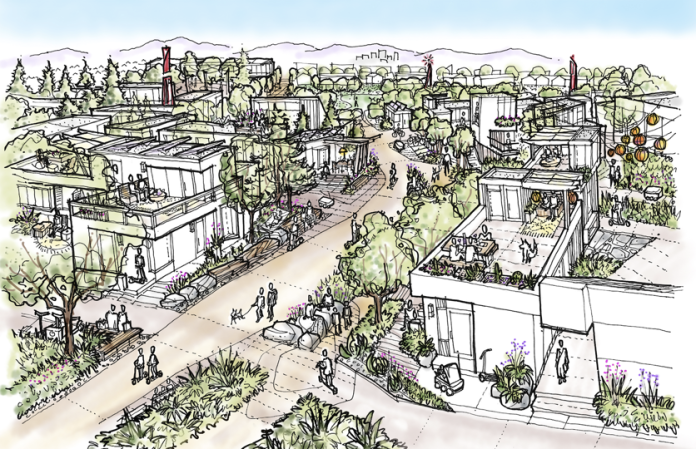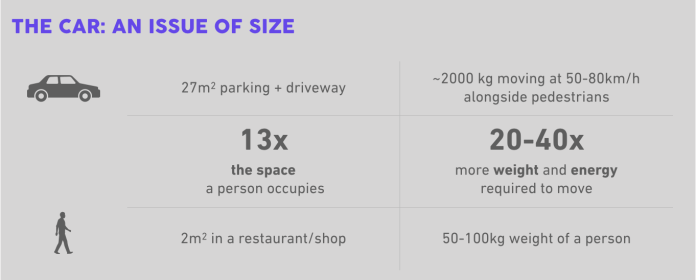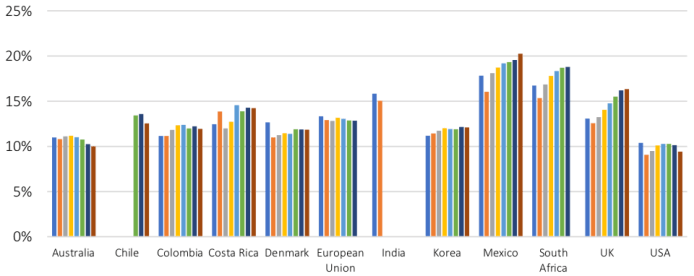This 2020 brings in not just a new year, but a new decade. With it, I believe, also comes an opportunity to really be bold about what we want our future to be like and not just conform with marginal improvements. 2030 lends itself as a good target to visualize and create a vision to work towards.
It excites me to think about tech and social trends/topics to watch for moving forward. These define how our lives and societies evolve and are also deeply linked. What would something with such magnitude of social impact as the gig economy be without technology: mobile devices, payment processing, ID verification systems, etc? This new decade certainly has a lot to bring. A very interesting concept that has taken my attention is the vision of cities without cars. Not just a city with less cars, but a city without cars at all. Bold?

Picture by Andrew Kambel (edited by me)
Cities without cars
The overall quality of life for the vast majority of people is and will be determined by the urban environment we live in. This urban environment however, has been shaped by the personal full-sized vehicle over the last decades. But now, the world’s cities are now growing at exponential rates and this model is impossible sustain. Yet, our ability to move quickly, affordably and sustainably is of fundamental importance. Visualizing a city without cars is very bold, but quite remarkable as well.
But, cities without cars? Seems impossible.
Well…Y-Combinator startup Culdesac for example, is actually building their first car-free neighborhood, launching this 2020 in Tempe, Arizona. It will be home to 1,000 people and instead of covering the neighborhood in pavement for parking and roads, more than half of the land area will be covered in landscaping, public courtyards, and greenery. Shops and entertainment will be right at your doorstep. Work in the city center? An on-site light rail stop will provide you easy access downtown. Shared, on-demand mobility through scooters and bikes will also be available. A small car-sharing lot and dedicated ride-hailing pick-up spots around the perimeter will facilitate the more tricky types of trips.

Rendering by NBBJ for Culdesac, taken from their Introduction
We can also talk about the 20-minute city/neighborhood model, where people can access their needs within a 20-minute walk, cycle or public transport trip. Cities such as Melbourne and Portland are already striving for this model, highlighting the importance of attractive and livable cities. Liveability is seen as a way to stay globally competitive, attracting more business and talent, as well as having links with general population health and environmental sustainability. A 20-minute city model translates to an area with a radius of about 5km and with a potential population catchment of 200,000+ people. It should provide a range of local activities and good accessibility to other high density nodes.
It’s time to be bold, let’s aim for cities without cars…
The trend of cities growing will continue, after all, these provide an immense set of opportunities for interaction with others, employment, entertainment, education, culture, etc. Our quality of life depends on the type of urban environment we live in. Cities under the current model of the personal vehicle will be limited in their growth or not be able to guarantee a good quality of life to their citizens, and therefore risk competitiveness with other cities. The current 1 person = 1 car model is not sustainable in the long run for growing cities, and likely not sustainable already for big cities. Meanwhile, cities without cars or striving to be car-free will benefit from lower traffic congestion levels, improved health outcomes, reduced emissions (GHGs and air pollutants), lower accident costs and greater social inclusion to name a few.

At some point during the year, London’s Regent Street is closed for cars. People can sit on picnic tables and enjoy live music, eat and drink, or walk along to shop. Photo by Abi Ismail.
What type of city would you like to live in?
It’s hard to imagine a city without cars, harder so to build one. However, the start of this new decade brings many opportunities and we could frame this as a vision to work towards. Cities around the world are already creating pedestrian-only zones, banning cars from city centers or implementing congestion charging and building dedicated lanes for alternative forms of mobility. We have an incredible range of technologies, business models and tools that are enabling a transition. Think of shared mobility – reducing our need to own a vehicle be it a bike or a car, videoconferencing – reducing our need to move across town for a work meeting or checking up on your family, electric micro-mobility – enabling us to move longer or faster without needing a car, urban farming – enabling us to get fresh ingredients and produce in our own backyard or across the corner, co-living/working – reducing the inefficient use of space, autonomous and drone deliveries – straight to our door without having to drive to the shop. These are all opening up the possibilities, and there’ll be many more to come. It isn’t easy, but it’s achievable. Let’s be bold and build the type of cities we want to live in.











